
The Percidae are a family of ray-finned fish, part of the order Perciformes, which are found in fresh and brackish waters of the Northern Hemisphere. The majority are Nearctic, but there are also Palearctic species. The family contains more than 200 species in 11 genera. The perches and their relatives are in this family; well-known species include the walleye, sauger, ruffe, and three species of perch. However, small fish known as darters are also a part of this family.
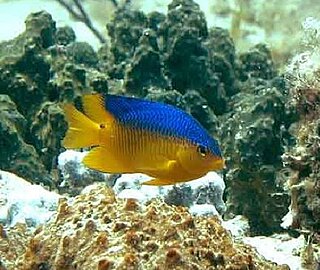
Pomacentridae is a family of ray-finned fish, comprising the damselfishes and clownfishes. This family were formerly placed in the order Perciformes but are now regarded as being incertae sedis in the subseries Ovalentaria in the clade Percomorpha. They are primarily marine, while a few species inhabit freshwater and brackish environments. They are noted for their hardy constitutions and territoriality. Many are brightly colored, so they are popular in aquaria.
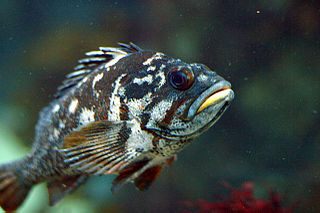
Sebastinae is a subfamily of marine fish belonging to the family Scorpaenidae in the order Scorpaeniformes. Their common names include rockfishes, rock perches, ocean perches, sea perches, thornyheads, scorpionfishes, sea ruffes and rockcods. Despite the latter name, they are not closely related to the cods in the genus Gadus, nor the rock cod, Lotella rhacina.
The Mastacembelidae are a family of fishes, known as the spiny eels. The Mastacembelids are part of the Order Synbranchiformes, the swamp eels, which are part of the Actinopterygii.
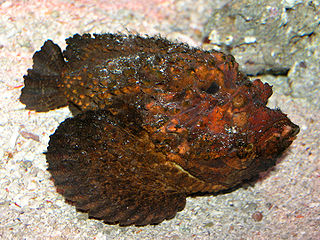
Synanceiinae is a subfamily of venomous ray-finned fishes, waspfishes, which is classified as part of the family Scorpaenidae, the scorpionfishes and their relatives. These fishes are found in the Indo-Pacific oceans. They are primarily marine, though some species are known to live in fresh or brackish waters. The various species of this family are known informally as stonefish, stinger, stingfish and ghouls. Its species are known to have the most potent neurotoxins of all the fish venoms, secreted from glands at the base of their needle-like dorsal fin spines. The vernacular name, stonefish, for some of these fishes derives from their behaviour of camouflaging as rocks. The type species of the family is the reef stonefish.

Anablepidae is a family of ray-finned fishes which live in brackish and freshwater habitats from southern Mexico to southern South America. There are three genera with sixteen species: the four-eyed fishes, the onesided livebearers and the white-eye, Oxyzygonectes dovii. Fish of this family eat mostly insects and other invertebrates.

Haemulidae is a family of fishes in the order Perciformes known commonly as grunts. It is made up of the two subfamilies Haemulinae (grunters) and Plectorhynchinae (sweetlips), which in turn contain about 133 species in 19 genera. These fish are found in tropical fresh, brackish, and salt waters around the world. They are bottom-feeding predators, and named for the ability of Haemulinae to produce sound by grinding their teeth. They also engage in mutualistic relationship with cleaner gobies of genus Elacatinus, allowing them to feed on ectoparasites on their bodies.

Oneirodidae, the dreamers are a family of marine ray-finned fishes belonging to the order Lophiiformes, the anglerfishes. These fishes are deepwater fishes found in the Atlantic, Indian and Pacific Oceans, and it is the most diverse family of fishes in the bathypelagic zone.

Oplegnathus is currently the sole recognized genus in the knifejaw family (Oplegnathidae) of marine perciform fishes. The largest, the Cape knifejaw, can reach a maximum length around 90 cm (35 in). Knifejaws have teeth fused into a parrot-like beak in adulthood. They feed on barnacles and mollusks, and are fished commercially. They are native to the Indian and Pacific Oceans.
Phallostethus is a small genus of fishes in the family Phallostethidae native to freshwater and brackish habitats in southeast Asia.
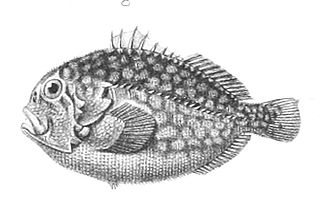
Caracanthus, the coral crouchers, or orbicular velvetfishes, are a genus of ray-finned fishes. They live in coral reefs of the tropical Indo-Pacific. This genus is the only member of the monotypic subfamily Caracanthinae, part of the family Scorpaenidae.

Tetraroginae is a subfamily of marine ray-finned fishes, commonly known as waspfishes or sailback scorpionfishes, belonging to the family Scorpaenidae, the scorpionfishes and their relatives. These fishes are native to the Indian Ocean and the West Pacific. As their name suggests, waspfishes are often venomous; having poison glands on their spines. They are bottom-dwelling fish, living at depths to 300 metres (980 ft). These creatures usually live in hiding places on the sea bottom.

Goodeinae is a subfamily of splitfins from Mexico, part of the family Goodeidae. They are small fish which mostly live in fresh water, especially around Mesa Central, west of Mexico City. Members of the subfamily are also found in brackish water on both the east and west coasts. They typically have small ranges and many are seriously threatened. The subfamily takes its name from its type genus Goodea and so is ultimately named after the American ichthyologist George Brown Goode (1851-1896).
Gulaphallus is a genus of fishes in the family Phallostethidae, native to the Philippines. They are mainly found in freshwater habitats, but G. panayensis is from brackish and marine habitats. It is the only genus in the subfamily Gulaphallinae.
Phenacostethus is a genus of fishes in the family Phallostethidae found in freshwater and brackish habitats in southeast Asia.

Poeciliinae is a subfamily of killifish from the family Poeciliidae which contains species from the Americas which are collectively known as the livebearers because many, but not all, of the species within the subfamily are ovoviviparous.
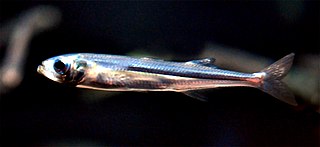
Atherinoidei is a suborder of the order Atheriniformes comprising six families, with a mainly Old World distribution, although a few species are found in the western Atlantic Ocean.

Phallostethinae is a subfamily of fishes, one of two subfamilies in the family Phallostethidae, the priapiumfishes. The species in this subfamily are characterised mainly by having highly protrusible jaws. The genus Neostethus appears to be the sister taxon to the other two genera in the subfamily. The species in the Phallostethinae are found in south-east Asia, the Malay Archipelago and the Philippines.

Procatopodinae is a subfamily of the family Poeciliidae, the "livebearers", in the order Cyprinodontiformes. Some authorities treat this subfamily as a family, the Procatopodidae, including the banded lampeye.
Lycodinae is a subfamily of marine ray-finned fish belonging to the family Zoarcidae, the eelpouts. These eelpouts are found are in all the world's oceans, with a number of species being found off southern South America.















